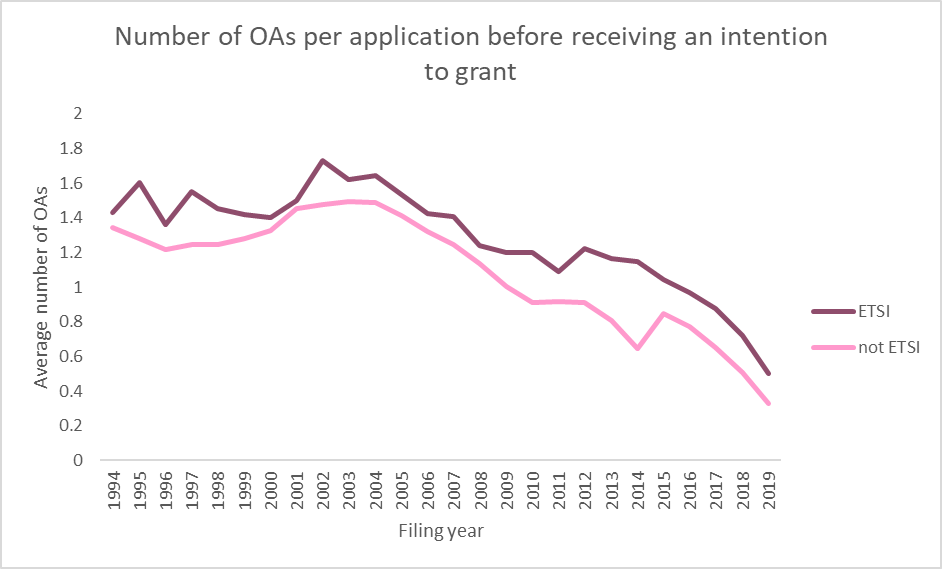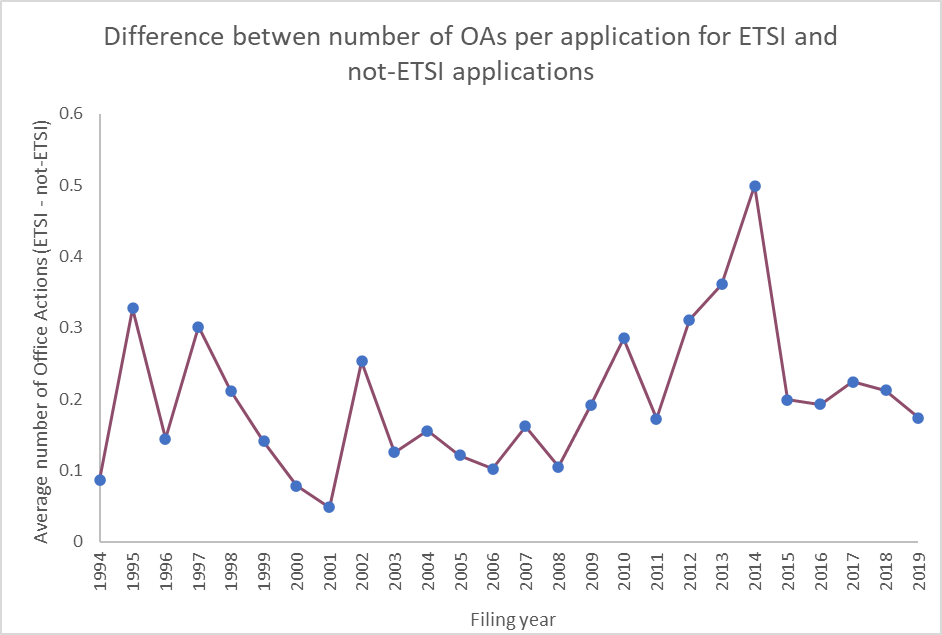This article is the latest in a series of blogs exploring whether declaring your patent or application as “essential to a standard” influences the outcome of that patent or application in Europe.
We know from our previous article that an application declared to ETSI as standards essential is more than twice as likely to grant as compared to an application not declared to ETSI. Of course, correlation does not always equal causation, so now we are using our data to explore: why are applications declared as ETSI are more likely to grant?
In this blog we are looking at:
Do applicants behave differently during prosecution of patent applications that were declared as ETSI vs applications that were not?
To try and answer this question we first looked at how many office actions (i.e., examination reports) were received from the EPO for the ETSI and non-ETSI applications in our dataset.
The plot below shows the average number of “communications from the examining division” that were received for each application before the application received an intention to grant.
NB: this plot does not include the European search reports, so applications that received an intention to grant after 0 communications will have at least received a search report.

There is a significant drop in number of office actions received for both datasets post-2015.
One reason for this is that applications which were filed more recently, and which have received a larger number of communications from the examining division may still be in prosecution. Therefore these applications have not yet received an intention to grant and do not feature in this plot.
Another reason is that procedures at the EPO have, in general, become more streamlined since 2015 resulting in the issuance of fewer office actions overall.
The plot shows that applications declared as ETSI consistently received more communications from the examination division than the other applications in our dataset. This is especially clear from the following plot which shows the difference in number of communications received, on average, between the ETSI applications and the not-ETSI applications.

In fact, the average number of communications from the examination division received for applications in:
- the ETSI dataset was 1.23; and
- the not-ETSI dataset was 1.03.a
One possible theory to explain the average higher number of office actions paired with the higher grant rate for applications declared as ETSI could be that ETSI-declared patents are likely to have more value than non-ETSI applications. Therefore, applicants in this area are more willing to spend more money and “try harder” to get their patent applications granted.
Another possible theory to explain the average higher number of office actions is that the technology declared as ETSI is sitting in a more crowded technological field than technology which is not declared as ETSI. Therefore, it is harder for applicants to establish novelty and inventive step of their ETSI declared inventions thereby requiring the applicant to undergo more rounds of examination until an allowable claim set can be agreed.
In summary, our data is showing that, on average, ETSI-declared applications tend to receive more office actions on the road to grant.
What’s to come?
In subsequent blog posts we will investigate whether ETSI-declared applications which did not go to grant were more or less likely to be abandoned or refused. We will consider whether this is related to the increased number of office actions and what this says about applicant behaviours.
We are also intending to examine the post-grant behaviour of SEPs vs not-SEPs.
Please get in touch if you have a question that you think our data can answer!
Tom is a Partner and Patent Attorney at Mewburn Ellis. He handles a wide range of patent work, including original drafting, prosecution and opposition, particularly defensive oppositions, in the engineering, electronics, computing and physics fields. Tom also advises on Freedom-to-Operate, infringement issues and registered designs.
Email: tom.furnival@mewburn.com
.png?width=110&height=110&name=rebecca%20frith-1%20(2).png)

-Dec-29-2025-09-11-25-2361-AM.png)
